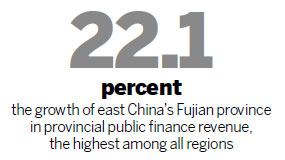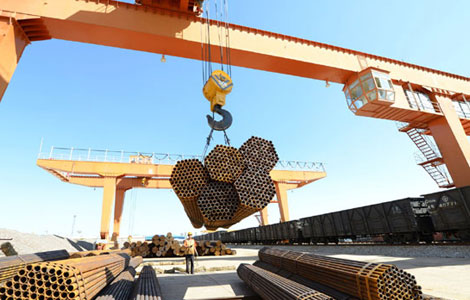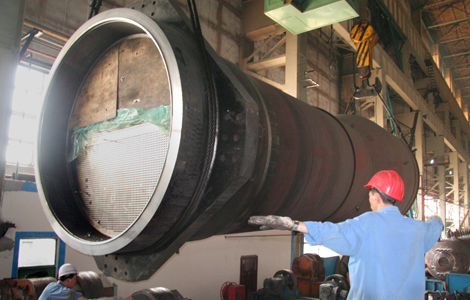Local governments' fiscal revenue growth slows
Updated: 2013-08-08 06:38
By Zheng Yangpeng (China Daily)
|
||||||||

Property boom helps provinces, cities hit half-year targets, despite slowdown in the overall economy
Local governments' fiscal revenue in the first half of this year generally slowed down compared with a year earlier but its growth was much faster than that of the central government because of surging housing-related revenues.
So far, 31 provinces, municipalities and autonomous regions across China's mainland have released their half-year fiscal reports. Although all have fulfilled their six-month targets, growth has significantly slowed, providing evidence of the slowing economy's toll on tax revenue.
East China's Fujian province recorded a 22.1 percent year-on-year growth in provincial public finance revenue, the highest growth among all regions. It was followed by southwest Yunnan province, which grew 20.5 percent.
In terms of absolute size, Guangdong province still led the country with a 348.3 billion yuan ($56.92 billion) half-year revenue, up 16.34 percent over a year earlier. It was followed by Jiangsu province, which grew 13.2 percent in the period.
Nationally, China's local fiscal revenue in the first half grew 13.5 percent to 3.628 trillion yuan, down from 14.4 percent growth a year earlier. But the growth of local fiscal revenue was well above the central government's 1.5 percent gain.
China's eastern regions maintained a steady revenue growth, while the figures for central and western regions generally fell to more than 10 percent. It was higher than 20 percent just two or three years ago.
For example, Guizhou province's fiscal revenue grew 17.3 percent year-on-year in the first half, down from 25.7 percent just a year earlier. Resource-rich Shaanxi province recorded a 12.62 percent growth, down from 26.6 percent a year earlier, affected by plunging coal prices.
While inland regions struggled, coastal regions maintained a steady growth rate, thanks to a booming property market in the first six months.
In Shandong province, brisk property transactions sent the province's fiscal revenue up to 253.6 billion yuan, a rise of 12.5 percent over a year before. Tax collected from the housing market totaled 43.2 billion yuan. Although it only contributed 17 percent of public finances, it accounted for 53.7 percent of the increment.
Guangdong's robust growth in revenue also relied on property. Housing-related tax contributed to 50 percent of the increment, according to provincial finance department.
"Real estate-related tax actually makes up a relatively small portion of the local government's public finance revenue but it contributed to a much higher proportion of the increment," said Bai Jingming, deputy director of the Research Institute for Fiscal Science under the Finance Ministry.
A total of 12 tax items are imposed on the development, sale and holding sector of the real estate industry. They include land value-added tax, deed tax, business tax and corporate income tax. Various other fees are also imposed on the property sector.
However, these do not include land transfer fees, a major component of government funds, which are not calculated as part of the public finance budget. In Guangdong for example, land transfer fees in the first half of the year totaled 117.5 billion yuan - more than a third of the province's public finances.
Nationwide, land transfer fees in 306 Chinese cities surged 60 percent to 1.13 trillion yuan in the first half of the year, according to 5i5j.com, a national housing brokerage. These fees are not shown in the current fiscal report.
"Excessive reliance on real estate income created conflicts of interest when it came to property curbing policies. They shaped the investment-led economic growth model pursued by local governments," said Feng Qiaobin, a finance professor with the Chinese Academy of Governance.
While local revenue growth slowed, expenditure increased significantly because local governments are required by the central government to increase their input into healthcare, education, agriculture and other sectors.
"Although fiscal revenue in the second half of the year is expected to grow steadily, the gap between revenue and spending is likely to widen, which puts mounting pressure on local governments," said Bai.
From Aug 1, VAT replaced business tax in nine industries across the region. This reform is expected to reduce by 120 billion yuan the tax paid by enterprises this year.
Some experts expressed fears local governments might increase fee collections to increase fiscal revenue. Tax and fees are two components of government fiscal revenue.
"Historically, every time tax revenues slow down, non-tax revenues surge. I am worried about whether the tax break for enterprises would be translated into the fees collected by local governments," said Li Weiguang, a professor of government finance at Tianjin University of Finance & Economics.
Most Viewed
Editor's Picks

|

|

|

|

|

|
Today's Top News
China's innovation prowess looms large
US, EU concerned about stalemate in Egypt
EU to continue anti-subsidy solar probe
Nation poised to import more GMO products
Illegal Shanghai stay costs foreigner 10,000 yuan
China to be leading business travel market
Cards make paying global tuition easier
Probes not targeting foreign brands
US Weekly

|

|












